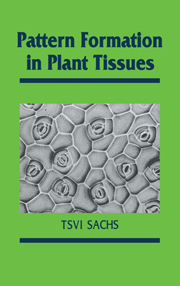Book contents
- Frontmatter
- Contents
- Preface
- 1 Introduction
- 2 Interactions of developing organs
- 3 Hormones as correlative agents
- 4 Callus and tumor development
- 5 The polarization of tissues
- 6 The canalization of vascular differentiation
- 7 Cell lineages
- 8 Stomata as an example of meristemoid development
- 9 Expressions of cellular interactions
- 10 Apical meristems
- 11 The localization of new leaves
- 12 A temporal control of apical differentiation
- 13 Generalizations about tissue patterning
- References
- Author Index
- Subject Index
8 - Stomata as an example of meristemoid development
Published online by Cambridge University Press: 05 October 2009
- Frontmatter
- Contents
- Preface
- 1 Introduction
- 2 Interactions of developing organs
- 3 Hormones as correlative agents
- 4 Callus and tumor development
- 5 The polarization of tissues
- 6 The canalization of vascular differentiation
- 7 Cell lineages
- 8 Stomata as an example of meristemoid development
- 9 Expressions of cellular interactions
- 10 Apical meristems
- 11 The localization of new leaves
- 12 A temporal control of apical differentiation
- 13 Generalizations about tissue patterning
- References
- Author Index
- Subject Index
Summary
THE CONCEPT OF MERISTEMOIDS
Stomata, hairs, secretory glands, sclereids, etc. are all examples of a broad class of structures that is difficult to define. It is their formation rather than their mature structure that is easily characterized: it involves a departure from the axial organization of a developing meristem (Chapters 5 and 10) through the appearance of a new, local polarity. The specialized cells formed by these departures from overall polarity cannot be simply related to the ‘canalized induction’ of vascular tissues and the polarization of the plant axis (Chapter 6). Because emphasis traditionally has been on mature tissues rather than on their development, there is no general term to cover all these structures; ‘idioblasts’ (Esau, 1977; Fahn, 1982) comes close, though it is generally limited to single cells and is also used in relation to specialized cells that run along the plant axis, such as laticifers.
A common early stage of cellular development that departs from axial or polar organization is an unequal cell division (Fig. 8.1; De Bary, 1877; Bünning, 1953, 1957). It is always the smaller product of such divisions that forms a specialized structure. The microscopic appearance of the small cells is distinctive: they have a dense cytoplasm and small vacuoles, characteristic of apical meristematic cells. The small cells are meristematic also in their ability to divide one or more times.
- Type
- Chapter
- Information
- Pattern Formation in Plant Tissues , pp. 101 - 117Publisher: Cambridge University PressPrint publication year: 1991
- 1
- Cited by

